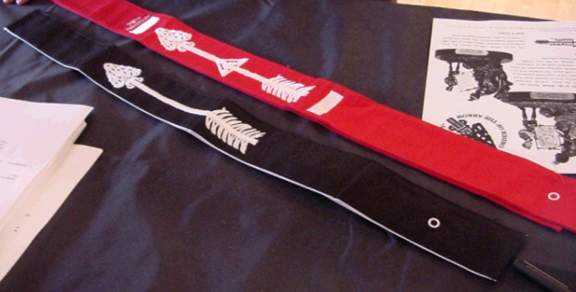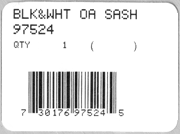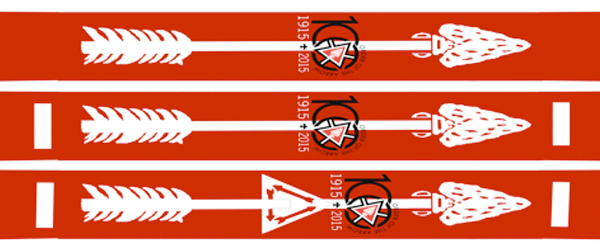

 Printable version
Printable version |
 |
|
The following is my expansion upon the National Bulletin article "Tracking the OA Sash Through Time" by Devang Desai, published in 1999: vol 51 Issue 1 & Issue 2. I've added my own additional research and created graphics to aid in the descriptions. Please do not copy this website, especially my graphics, as this represents significant additional material and research. If you wish to copy this article, please download the official published versions from the National Bulletin website, and DO NOT include my graphics or material without my permission. | |||
Since its beginning in 1915, the Order of the Arrow has recognized its members with a visible sign of membership-- the Order of the Arrow sash. Although times have changed, use of the OA sash has remained fairly constant.
According to the Order's fifth Vigil Honor member, Harry A. Yoder, in the early days of the Order the members wore black sashes[, which were called "bands",] with a white stripe running lengthwise instead of the white sash with the red arrow. The original sash was black because it offered a great contrast to the white bar and it blended well with the black ceremonial robes. (Yoder also served as a guide and guardian in the first OA ceremony, on July 16, 1915.) | |||
|
[This is contrary to what BSA National promoted for the 75th Anniversary, when awards and other memorabilia depicted the first black sashes with white arrows. In 1992, when I was serving in Woodland District, Philadelphia Council, I was told by several Unami Lodge officers and members that these first sashes had white stripes or bars, not arrows. That same year, Unami issued several flaps (s14 and s15) that depicted this. This is also supported by the 60th Anniversary First Degree Ritual reenactment that Dr. Goodman attended and posed with. In the ISCA article "The Black Arrow Sash," Bill Topkis and Jeff Morley state "There is strong speculation among today's historians that the original sash did not bear an arrow, but rather a bar. It is believed that the arrow surfaced sometime shortly after the initial ceremony in 1915... with references to arrow pins dating as early as 1916 as well as the original Constitution of the Order." (8). In his book, the Kekeenowin of the Wimachtendienk, Terry Grove proposes a compromise theory that a thin archery-like arrow could have been described as either a stripe or an arrow (376).]
Sashes from this time period are rare to find and, though rumored to exist in private collections, no black sashes from this era have surfaced publicly. [In a 1998 posting to Patch-L, Bill Topkis questions their very existence. He recounts that in 1989 National contacted himself and other collectors but they were unable to locate a "black sash" for the 75th Anniversary.] Unlike our present three levels of membership, the Order of the Arrow originally had only two levels [called degrees]. The [First Degree] combined aspects of the present-day Ordeal and Brotherhood memberships, while the [Second Degree] was an early adaptation of the Vigil Honor. In 1915, the OA did not exist as a national organization, nor did it have lodges. The Order was referred to as simply as ["Wimachtendienk W.W."]. During the early 1920s, the brothers gathered to establish and formalize the organization. They created the Unami Constitution, which laid out the Order's vision. It was at this time that the symbol of the Order was adopted-- a white sash with a red arrow. [The 1920 constitution formalized the new Second (Brotherhood) Degree and renamed the highest membership level the Third (Vigil) Degree. The 1925 constitution named the three levels of membership Ordeal Degree, Brotherhood Degree, and Vigil Degree. In later years, two other degrees were also considered but abandoned: in 1926, "a new degree between Brotherhood and Vigil, called the Dramatic or Service Degree" (Davis 25) and in 1930, a new Fellowship Degree that relegated Brotherhood to a "confirmation of the Ordeal pledge" (Davis 30).]
In this era, Arrowmen who were [First (Ordeal) Degree] members wore a white sash with a red arrow over their right shoulder. [Second (Brotherhood) Degree] members wore a white sash with a red arrow over their left shoulder. A brother in the Vigil Honor wore three sashes-- one over the right shoulder, one over the left shoulder and one around the girth of his waist. [The only two known examples of these "bib" are shown in the photo below being worn by Goodman and, above and to his right, I believe Horace Kern*. Another question is why only eight of the other participants were wearing a sash as Second (Brotherhood) Degree members. Perhaps they had just completed their Second Degree?]
See also an excellent article regarding Early Vigil Honor Sashes, by Paul Myers
Each OA lodge was responsible for producing its own sashes. The BSA Supply Division did not produce OA sashes. Lodges would generally make sashes out of felt with canvas or felt arrows. In 1927, the Supply Division began producing Ordeal sashes for the growing OA organization. Sash collectors have identified sashes from the 1920s by the thickness of the arrow's shaft. [The earliest Third Degree known bands to exist can be dated to as early as 1924. They featured a red triangle with white clockwise or counter-clockwise arrows on a plain white band that did not have an arrow. Grove explains (381) that at this time the triangle, not the arrow, was the symbol of the Third Degree. Unlike a later arrow-less design, instead of being centered on the band, the triangle was located higher up towards the shoulder, usually above the wearer's heart (Myers 10). Both Grove and Myers note that the arrow shafts extend past the fletching to form a notch which distinguishes this design from the 1933 arrow-less sash design. In 1928, a new design that did have an arrow, but featured a white triangle superimposed with three red clockwise arrows was introduced.]
In 1933, the OA produced a [Third Degree band.] It was a white felt sash with no arrow on it. The felt sash had an oversized felt triangle with three felt arrows. (The earliest Vigil sashes had three arrows pointing in a clockwise position.)
[At the Autumn 1933 meeting of the Grand Lodge, the Third Degree band was specified as a "an Ordeal membership band, worn over the left shoulder, bearing a red triangle and three white arrows pointed clockwise", and so the] arrow was added [back on] to the Vigil sash. The sash was also made of a cloth backing on the felt, which in turn would help preserve the felt. [The red felt vigil triangle had white felt clockwise arrows]. The next major change on the Vigil sash was the use of embroidered arrows in the oversized triangle instead of felt arrows. In addition, the backing was removed from the felt sash. [Both clockwise and counter-clockwise varieties of this design exist.] [At the behest of the National Council BSA (Davis 49), the 1935 Constitution of the National "Tribe" changed some terminology. Levels of membership were to be called "Honors" instead of "Degrees", e.g., Ordeal Honor, Brotherhood Honor, and Vigil Honor. In 1953, "Honor" was dropped from Ordeal and Brotherhood (Davis 73).]
Around 1946, OA founder Dr. E. Urner Goodman created a Vigil Honor sash for members of the National OA Committee as a way of thanking them for their service. This limited edition Vigil Honor sash had a white arrow on a red sash with white [counter-clockwise] arrows inside the oversized felt Vigil triangle. [The Mar/Apr 2013 edition of the National Bulletin also claims that "For the 1950 NOAC, national committee members wore Vigil bands of reversed colors so they could be easily found by lodge members that had questions about the Order being fully integrated into the Boy Scouts of America."]
In 1948, a major development occurred. This is the period that collectors call "flock on felt." The sash itself was made of [wool] felt, but the arrow used was flocked. [A thin glue is silk-screened onto the felt and red synthetic fibers, about 1mm in length, are sprinkled or flocked over the adhesive pattern and allowed to dry. This gives a nice, thick, fuzzy look and feel to them.]. The Vigil Honor sash was also flocked, and had an arrow with an oversized felt triangle, while [the clockwise/counter-clockwise] arrows within the oversized triangle were silk-screened.
[At the December 1949 National Meeting, it was decided that all sashes would then be worn over the right shoulder. Brotherhood sashes would be differentiated by a small white arrow on the center of the arrow shaft (Davis 69). Actual examples of such as sash has yet to be documented. In any case, by spring 1950] bars instead were flocked onto the [Brotherhood] sash. [At the Feb. 1951 National Committee Meeting, it was decided to change the Vigil Honor sash to match the Brotherhood sash, (Davis 72) with] the oversized felt triangle reduced and flocked onto the sash. The flocking of OA sashes ended in 1954 with the introduction of twill cloth with embroidered arrows.
As the use of twill cloth became dominant, two major stitches were used to bind the edges of the cloth sashes. The first was the railroad track stitch, or the double-stitched edge (used mostly from 1955-59), and the second was the rolled-edge stitch (used mostly from 1960-80). In 1980, the stitching on the twill cloth sashes changed from rolled-edge to chain-stitched edges. The last of the chain-stitched sashes were made in 1988, at which point single stitching was used.
In 1988, the [BSA National Supply Division] created twill cloth sashes with iron-on or appliqued arrows. These sashes were produced for only two years because the arrows were literally peeling off. [These sashes were called "lick 'em & stick 'em and lick & stick, as they were notorious for the iron-on design to come off in the washing machine. In 1990,] the OA then returned to embroidered arrows (including the insignia for Brotherhood and the Vigil Honor) on [a heavier cotton] twill using a single-stitched edge. [This is also when the design of the triangle on the Vigil Honor sash was changed from clockwise back to counter-clockwise arrows.]
To commemorate the 75th anniversary of the Order of the Arrow, the national organization reproduced a collector's black sash with white embroidered arrows as a souvenir for the 1990 National Order of the Arrow Conference. [It had a white cloth inner band so that one could collect autographs.] To ensure that members did not wear this sash, it was produced without a snap-clasp and was made shorter than the average sash.
In 1990, the national chairman of the OA committee, Dr. Carl Marchetti, produced a [red] sash for members of the national OA committee that was a replica of Goodman's gift to the 1946 OA committee. The sash was to be worn by committee members, the national chief, and national vice chief only during Founders' Day at the 1990 National Conference. [This sash had "75th Anniversary" embroidered in white lettering at the top.]
Dr. Marchetti stepped down as chairman of the national OA committee on June 15, 1993. To celebrate his tenure as chairman, he produced a limited number of black Ordeal sashes with a white embroidered arrow [and a white cloth inner band] for the national chief, national vice chief, and members of the national OA committee. Each sash was numbered and contained a special personalized message from Dr. Marchetti. [As shown in the photo below, it had a white snap-clasp.] Through the years, the use of the OA sash has remained constant even though there have been occasional changes in the stitching and positioning of arrows inside the Vigil triangle. During the 83 years of the organization's existence, the sash continues to remain the visible symbol of service as was intended by the Order of the Arrow cofounders. (Information for this article was obtained from Order of the Arrow historians Kenneth Davis, Terry Grove, and Harris Tanner.)  White on Red, White on Black 1993 National Committee Black Sash and 1990 75th Anniv. National Committee Red Sash on display for the 2000 NOAC, from the Official National OA Site
See also Evolution of Sashes, National Order of the Arrow More original material by Robert Higgins: Clockwise vs Counter-clockwise Vigil Arrows
| ||||||||||||||||||||||||||||||||||||||||||||||||||||||||||||||||||||||||||||||||||
 |
| National Bulletin, Feb. 1937 |
Confusion over the clockwise vs counter-clockwise white arrows within the Vigil triangle has remained for over seventy years. The earliest known Third Degree/Vigil sashes were made with clockwise arrows. Even early on, however, some counter-clockwise sashes did appear. Grove (382) documents Edward Pilkington's Third Degree band from 1924, which had the same design as the earliest documented sashes but with counter-clockwise arrows instead. Even after National started producing sashes in 1927, the orientation has flipped back and forth several times since.
Indeed, at the September 1936 meeting of the National Lodge, a reminder of the correct design was announced: "The correct Vigil Honor band is a regular arrow band... with a red triangle with three white arrows pointed clockwise superimposed upon it." (Davis 52). This was again reiterated in the February 1937 National Bulletin by National Chief Joseph Brinton, who reminded lodges of the correct clockwise design (Davis 53) and included a sketch of the correct Vigil Honor Band (Grove 383).
According to the authors of Arapaho I (Hoogeveen, Breithaupt 183), a forgotten manufacturing error from the 1920s perpetuated the incorrect counter-clockwise design. When drawings and photos of sashes first appeared in handbooks in 1961, they again duplicated earlier sashes with the counter-clockwise arrows-- even though Vigil pins and certificates kept the clockwise orientation.
In 1971, Richard Breithaupt brought this to the attention of National and was told that, because of the difficulties and expense in correcting this mistake, sashes would be corrected as supplies ran out and sashes were re-ordered. These corrected sashes first appeared around 1978 ("Sashes" 3), and were mirror images of the prior embroidered design. Both clockwise and counter-clockwise Vigil Honor sashes were produced until 1988. That year the supply division experimented with using an iron-on applique design with a clockwise arrows. After two years, this construction was switched back to embroidery and the clockwise arrows disappeared (Leighty).
 2006 NOAC Commemorative Black Sash |
A commemorative black Ordeal sash was sold for the 2006 National Conference. It included a metallic silver Sharpie® permanent marker ("ORDER OF THE ARROW" emblazoned in black) for signing autographs, and until recently it was available at the OA Trading Post Online. The sash features an embroidered silver-white arrow on black twill, with a white inner band for autographs. As it was not designed to be worn, it does not have a snap and is very, very short, only 38-inches-- which barely fits over the shoulder. Compare this to the 60- and 72-inch lengths of current sashes.
Black Sash Similarities |
2006 NOAC Black Sash |  2006 sash barcode sticker | |
 |
1990 NOAC 75th Anniv. Black Sash |
Because of their similarities, many have asked how to tell the difference between the 2006 NOAC black sash and the 1990 NOAC 75th Anniversary commemorative black sash:
Please be sure to consider all of the above comparisons before deciding which sash you are dealing with.
2010 National Committee Red Sash

For Scouting's 100th Anniversary, past Chief Scout Executive Bob Mazucca presented a red and silver vigil sash to each member of the National Committee. They were individually numbers, and the back featured the 100th anniversary BSA logo. (Brendel)


In 2013, the 100th Anniversary Youth Advisory Committee made a proposal, which was subsequently approved by the entire the National OA Committee, to give each 2015 NOAC attendee a special edition red sash. Embroidered Ordeal, Brotherhood, and Vigil Honor sashes, reversed white-on-red in the current style, will be given out during a special program. As these are intended to be special commemorative item, only those in attendance will receive them, and any remaining extras won't be sold. (Brendel 2)
In the article Centennial Update: NOAC Commemorative Sash, Forrest Gertin writes "The 2015 National Order of the Arrow Conference will be marked by a special commemorative red sash given to each guest and staff member. The sash will not be level specific, so each Arrowman-- an Ordeal, Brotherhood or Vigil Honor member-- will receive the same design on their sash. These souvenirs are also available as a thank you to those adults who gave up their spot as a lodge contingent member because of the recently capped conference attendance. Every adult who was registered for the 2015 NOAC through October 10th, 2014 will have the opportunity to purchase the inverted sash."
 |
 |
 |
| from eBay | from eBay |
Not to be confused with the official 100th Anniversary Commemorative Red Sashes, in 2015 Eswau Huppeday Lodge #560 issued their own collectable red sashes as NOAC fundraisers. While these were lodge issues, not from National, they were professionally designed and available in three versions: Ordeal, Brotherhood, and Vigil.
To the best of my sources, no other authorized black or red sashes have been issued. Periodically, you may see on eBay or even at trade-o-rees other black or red arrow sashes, including O-B-V versions. Just be aware that these are reproductions or lodge or private issues that are usually priced much lower than the genuine article, and are fine for ceremonial teams or for display (Brendel 2).
Works Cited:
|
 book by Terry Grove, includes copies of all ceremonies from 1916 to 1948 known to exist; history of the Ordeal, Brotherhood, and Vigil Honor; membership cards, sashes, handbooks, & local lodge materials. |

|
History of the OA Sash Created: 04-05-2005 This page updated: webmaster@oasections.com |
OASections.com |
|
 |
Original material copyright © 2005-24 by Robert Higgins. All rights reserved. All other copyrights remain the property of their respective owners. |